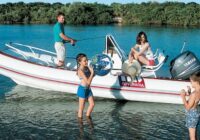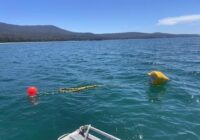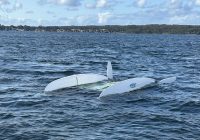By Hans Buitelaar – METSTRADE.com

Part 1
Exciting new technology will be presented at the next METSTRADE show at the all-new Start-Up Pavilion (STP). In co-operation with Yachting Ventures the show floor area for fresh inventors in the yachting and boating industry will show technology for the improvement of on-water leisure time and nautical businesses.
Keen to participate in the first edition of the pavilion, lots of recently started small companies that try to gain attention for the innovations they develop, registered with Yachting Ventures (YV). This London-based platform aims to be the hub for start-ups in the yachting industry, bringing together network, education and opportunities for these pioneers. “The pavilion was filled overnight,” YV founder Gabriella Richardson recalls. “We have a very impressive selection of participants. All of these companies also have to meet the quality standards that METSTRADE requires to be a full participant in the show, so not all of these recent starters have been confirmed yet.” The innovators that meet requirements already present a comprehensive look on yachting in the (near) future.
Intelligent video safety
AI is emerging everywhere, likewise in yachting. Captain’s Eye is a multi-camera monitoring system that can detect smoke, intruders coming aboard, changes in the pattern of system functioning and it allows skippers to watch and review video images taken by the cameras on board, remotely on their mobile devices by using an app. Video can be viewed through a live connection or from previous recordings. The algorithm of the Captain’s Eye system teaches itself what the normal operation on board looks like and will issue a warning if the normal modes of operation are disturbed. The program has facial recognition. The owner or captain can take pictures of the crew and authorised people to come on board and the security system will recognise them. Guests can be introduced with a temporary admission. After their stay, the system will issue alerts when they try to re-board the yacht. Using the Captain’s Eye app, a yacht captain can control the cameras. A mast-mounted camera for example can be tilted to get a view of the marina or anchorage and see if all is clear. Captain’s Eye integrates with existing CCTV (Closed Circuit TV) systems. Smoke and fire aboard is automatically detected and will cause an active alert. The exact location of any misfunctioning aboard will be indicated, allowing the quickest possible action from staff to solve the problem. Developers claim that their AI system can detect smoke sooner than fire detectors. The start-up with the same comes from Israel, where retired Navy Captain Uri Ben-Dor and a defence force Colonel Doron Oizerovich joined forces to create this Artificial Intelligence security system for yachts. The investment fund SixAI, specialising in new technology that combines optics, edge computing and AI, has become the company’s major investor by granting 4 million US dollar.
Visit www.captain-eye.com
Certified logging
Digitization of systems on board is cleverly applied in the digital logbook that gathers data from all the onboard systems. Aboard super yachts, but nowadays also aboard mid-sized yachts, ever more systems are connected. That is the case with the navigational instruments, but also engine controls, sensors, plotters and even the controls of household equipment are increasingly integrated in a central monitoring and control system. A program or app that gathers these data and cleverly organises it, can write a digital log book. Course, heading and speed are registered, like engine hours, fuel consumption, weather conditions and use of onboard equipment. Names of crew and guests can be entered as well as destination. The eLogbook by L.J. Commercial Services does all of this. It is the brain child of former superyacht steward and purser Liz Jackson, founder of the company. The digital and automatic recording of a yachts’ proceedings and performance as well as the use of resources replaces a whole collection of manual log books: the engine room log book, the navigational log book, the oil log book and the guest log book, to name few. What is registered in all of these log books is crucial for safety and insurance purposes. The L.J. eLogbook is certified by Lloyds Register and recognised as a suitable replacement of manual log books by the UN maritime authority IMO. Having a computer automatically register ship’s data and make a log book from these that is very convenient, L.J. Commercial Services likes to point out.
Visit www.lizjackson.co.uk
Traffic light for batteries
Electrification of boat equipment and propulsion relies on proper functioning batteries. Fleet managing companies like boat charterers and even yards that agree with their customers to keep track of the maintenance status of their yachts need to be aware of the status of battery packs before they fail. Connecting all the batteries and the battery monitoring devices to the IoT platform of the Czech and Slovak company Battery Check allows remote monitoring (the company has offices in both Prague and Bratislava, re-connecting the two capitals).The app on mobile or desktop devices shows the condition of all batteries in a glance: green means no problems, yellow calls for maintenance and red indicates the need to replace a battery. The clever logarithm recognises battery specifications to understand performance requirements. Any kind of battery can be connected: those of mobile devices, vehicles – like boats and yachts – the household batteries that buffer solar power for nighttime use, electric car batteries and more. If a monitor for any specific battery is not there or not connected to the internet, the company provides an API (application programming interface) that connects the device to the internet and communicates with the Battery Check platform.
Visit www.batterycheck.com
Part 2
At the new Start-up Pavilion on METSTRADE, innovators are keen to show their newly developed products that may change the boating and yachting experience. Here is a preview on the companies that have been officially confirmed.
“At the pavilion, we show both software innovations as well as new hardware products,” organiser Gabriella Richardson from Yachting Ventures shares. Using the connectivity that a lot of modern electronic devices already have, new intelligent software is developed to improve monitoring, safety and experience of boating. Some innovations require hardware however, to eliminate emissions from combustion engines for example.
Rental documents digitised
Working fully remote with skilled colleagues in Amsterdam, London, Alexandria Cracow and Poznan, Floatist embodies the modern innovative software provider. Their platform for yacht charter companies combines connections to the on-board systems with remote monitoring possibilities from the charter company office and an app for the customers. All of the documents for renting a yacht or boat can be handled over the app, the lists of necessities on board that are shown during the check-in is presented in the app, like the manuals of all the equipment on board. Customers can trouble shoot equipment that is not functioning themselves, often to find that some switch should be flipped. From the office, the charter company can register all the paperwork digitally and have all required document related to any yacht brought together. Performance of connected systems, fuel usage if connected, documentation of systems on board and financial details are presented in a single overview, making the administration of boat rental much easier. A track record of maintenance kobs for each yacht is registered. Founders, experienced as charter skippers, discovered the need to make charter companies more efficient and make the check-ins and service requests for customers much easier.
Visit www.floatist.com
booking.com of boating?
Versatility appears to be the stronghold of German start-up Metarina, that offers a software platform for marinas and boaters to book berths and that offers marina management tools. A bit like the introduction of hotel booking platforms some decades ago, nowadays the marina booking platforms are competing to take a dominant market position. Three high school friends that all got into yachting after their studies and at some point occasionally met aboard a yacht in the Mediterranean. They gathered around a commonly felt mission to simplify communication between marinas and boaters and marinas among each other. Connected marinas, that may be commercial enterprises, public and municipal yacht harbours, yacht clubs and even marina associations can centralise their customer information and manage berth occupancy registration. Metarina claims to help marina operators to optimise berth occupation and make operations more efficient. Key to success with a booking platform remains customer acceptance and use. The boater’s app is not available on the platforms for mobile apps yet, as the software roll-out is in the development phase.
Visit www.metarina.com
Sail on air
Air lubrication is a novel technology still in a quite experimental phase in inland shipping and under the hulls of sea going merchant vessels. While the ideas for air lubrication exist for more than two decades and vessels have been equipped with various systems that create a ‘carpet’ of air bubbles under the ships hull in order to reduce resistance of the hull in the water, the concept has not been presented as a product until now. Progressing from research programs into air lubrication conducted by the Norwegian R&D company Effect Ship International (ESI), start-up Pascal Technologies developed a hull form that is designed to effectively reduce resistance in the water by the use of an air-bubble layer under the hull. While the water resistance of the air lubricated hull is not very different from conventional hulls at low speeds, the increase of resistance that grows with higher speeds is significantly less when the hull rides over its air carpet. The AirHull consists of the air system, driveline, and batteries. All components are integrated and regulated by our ride control system. The platform architecture is scalable for boats from 6 meters to 30 meters. Lower resistance at higher speeds offers possibilities for electric boating. The Oslo-based team of Pascal there for provides the AirHull as a ready-engineered vessel with electric propulsion. The company aims to help reduce emissions in boating and yachting, rather than allowing combustion engine powered yachts to reach higher speeds. AirHull boats can be runabout motor boats, fishing boats, water taxis of passenger ferries.
Visit www.pascaltech.com
Tube engine
Redefining marine electric propulsion, start-up Zparq from Sweden engineered an electric motor that is lighter, causes less drag and produces more power than electric propulsion has achieved before. Cooling water flows through thew middle of the tube-shaped engine, reducing drag and optimising flow along the propeller blades. As the rotor and stator of the electric engine are directly connected to the propeller blades, there are very little moving parts. The light design reduces raw material and CO2 footprint in the production phase, and the products are designed with a circular approach to reduce environmental impact and climate footprint over their entire life cycle. Zparq originates from a collaboration between the founders and Royal Institute of Technology in Stockholm (KTH), where the technology has been developed and tested on underwater robots and foiling vessels, since 2017. Zparq AB was founded in 2020. Santander InnoEnergy Climate Fund and Almi Invest GreenTech recently funded the start-up with 2.5 million euro to get production and distribution at a larger scale.
Visit www.zparq.se
For more information visit METSTRADE.com
To keep up to date with all marine industry news visit www.marinebusinessnews.com.au








